Frances Denney
Continued onto: Frances Denney (post 1945)
The story of Frances Denney begins in Philadelphia with two sisters, Anna and Helen Denney. In the 1900 census we find them unmarried, living with their brother, William Denney and his family at 1542 Wallace Street, Philadelphia, along with a lodger to help make ends meet. William was employed as a machinist, Anna was working from home as a manicurist and chiropodist, and Helen was teaching Physical Culture.
The document pathway to Frances Denney continues with the creation of the Victoria Toilet Company. Founded by Helen Denney at 1008 Walnut Street, Philadelphia it was first listed in the Philadelphia directory in 1903. By 1906, the Victoria Toilet Company had been replaced by Denney & Denney in the Philadelphia directory. It was based at 129 South 16th Street, Philadelphia, with both Helen and Anna Denney listed with the company.
The 1906 directory listed the operations of Denney & Denney as ‘manicures’ but this had changed to ‘hairdressing’ by 1908. The hairdressing services appear to have included Marcel Waving, a technique invented by Marcel Grateau [1852-1936] in the late nineteenth century. It was very popular before the introduction of the permanent wave and very difficult to do alone at home.
Anna and Helen were still living with their brother and his family when William joined Denney & Denney in 1909. However, the extended household broke up after both Helen and Anne got married – Helen to Richard L. Heverle [c.1878-1961], an accountant, in 1909, Anna to Charles Ellsbar Bachman Jr. [1873-1932], a salesman, in 1911. In between these dates, the firm of Denney & Denney incorporated (capital US$50,000) with Joseph A. Browne [1860-1937], Richard Hevele’s brother-in-law, as its treasurer. 1910 was also the year that Denney & Denney was said to have opened a salon at Wanamaker’s Department Store in Market Street, Philadelphia.
The three siblings remained with the firm until 1916 when Anna Denney, now Mrs. Anna Bachman, is no longer listed as part of Denney & Denney in the Philadelphia directory. Her exit appears to have been amicable as she was living with her husband next door to William Denney and his family in the 1920 census.
By 1909, Denney & Denney had moved to 1501 Walnut Street and the business of the firm was now listed in the Philadelphia directory as ‘toilet preparations’. A second address at 27 North 7th Street was added in 1915 and reports of a fire there suggests it was used to make and/or store cosmetics. This might indicate a separation between the beauty salon, which had moved to 1513 Walnut Street by 1917, and the manufacturing side of the business.
The conversion of Denney & Denney to Frances Denney began in 1928, a date that coincides with Denney & Denney appointing McKee & Albright, Philadelphia, as their new advertising agency. It is possible that this agency was responsible for the idea, perhaps convincing the management of Denney & Denney that having a female associated with the company would increase its credibility with its female customers.
The name Frances Denney appears to have been taken from William Denney’s wife, Elizabeth Frances Denney, née Cunningham. Her first name, Elizabeth, could have been used instead of Frances but there was already a prominent Elizabeth in the beauty business – Elizabeth Arden. Like Miss Elizabeth Arden, it was also Miss Frances Denney.
Open Corporates suggests that a company called Frances Denney was created in 1928 but this did not mean the immediate end of Denney & Denney. Frances Denney just became its imaginary figurehead and spokesperson and a suitable backstory combining a few facts with a lot of fiction was later developed to outline her supposed role in the history of the company.
The story of Frances Denney is as beautiful and endearing as any historical novel. It spans over 100 years, 4 wars and 3 generations of a family. It is the story of a dream, persistently sought after and attained.
Frances Cunningham, a pretty Irish Girl form Drogheda, Ireland broke with the stereotypes of the late 1800’s and enrolled in Trinity College in Dublin. She became the first woman to graduate with a degree in chemistry. Shortly after sailing to the United States, she combined her knowledge of chemistry with a spirit of innovation and created a new industry by opening a fashionable salon in Philadelphia in 1897. Coincidentally, the day her salon opened, she was celebrating not only her own birthday but also the birth of the first Cosmetic House in America.(Frances Denney website, 2012)
I have no evidence that Elizabeth Frances Cunningham was ever actively involved in the business of Denney & Denney and, given that she was five when she arrived in America in 1870, it seems highly unlikely that she attended Trinity College in Dublin.
Products
The Victoria Toilet Company was listed making at least one cosmetic in 1904 – The Ideal Deodorant. This leads me to think that Denney & Denney were also producing some cosmetics when the business was established around 1906.
By the time America entered the First World War in 1917, the Denney & Denney range included toilet waters in a range of fragrances, skin-care cosmetics – cleansing cream, skin tonic, and tissue food; make-up – face powders, a liquid powder, and rouges; and toiletries – soap, toothpowder deodorant, and brilliantine.
In some advertisements the company’s products were credited to Denney & Denney but in others they were referred to as Denney’s, Denneys’ or Denneys. These alternatives gradually fell away in the 1930s after Frances Denney was introduced in 1928 although there were still occasional references to Denney & Denney right up to 1940.
Skin-care
Most of the skin-care cosmetics in the Denney & Denney product range prior to 1930 were developed before the First World War. They lacked originality but covered most of the expectations for a skin-care range of the time with the basic skin-care regime following the standard practice of cleansing with a Cleansing (Cold) Cream, toning with a Skin Tonic, and then feeding the skin with a Tissue Cream/Skin Food.
Cleansing Cream: “Gently penetrates the pores and removes dust and dirt quickly and easily. This will clean the skin better than anything you have ever used. For morning and night, and after automobiling, shopping, and exposure of any kind.”
Skin Tonic: “[R]efines the pores, strengthens facial nerves, and makes the skin smooth and healthy.”
Tissue Cream: “Best of all Tissue Builders—it is real food for the skin. To keep away and banish lines and wrinkles, and nourish the tissues. Excellent for thin and ageing faces, and for withered skin.”
See also: Cold Creams, Skin Tonics, Astringents and Toners and Skin Foods
Other skin-care lines produced by Denney & Denney through to 1930 that I know of are:
Muscle Oil: “To bring new life to the skin that is sallow, dull, or without color and freshness.”
Skin Bleach and Freckle Lotion: “[A] liquid bleach that aids in removing faded tan, freckles and discolorations.”
Velvet Cream: “[F]ar superior to cold cream. Best suited for rough and chapped skin, after bathing and outdoor sports. Cleans, heals, and softens. Delightful base for powder.”
Skin Balm: “For the hands and body, to prevent redness, chapping and dryness. This will keep the face and hands soft, smooth and white. Even the roughness on the elbow is softened. Only a little is necessary and does not leave the hands sticky. Especially for use on tender delicate skin, for it leaves the skin like velvet.”
Astringent: “To reduce large pores and tighten relaxed muscles … to tone the skin and make it firm.”
White Mud Pack: “Cleanses—Whitens—Beautifies. The development of years of experimentation to produce the perfect complexion day. Contains no grease or alkali. Does not grow hair.”
Velvet Cream, Skin Balm, and Skin Bleach and Freckle Lotion were available by 1925, Muscle Oil by 1927. However, the only preparation I can date with any certainty was the White Mud Pack which was introduced in 1922 during the American complexion clay fad of the early 1920s.
See also: Complexion Clays and the A.M.A.
Make-up
Face powder and rouge were both in the prewar Denney & Denney product range. The face powders only came in four shades but were available in a range of scents. I don’t have any evidence that Denney & Denney made a lipstick before 1920 but Rose Tint was a liquid rouge that could be used on either the cheeks or the lips. At some stage the business added a Shading Cosmetique for the eyes and there is also a record of a vanishing cream in the 1920s that would have been used as a powder base.
Face Powder: “[A] delight to use, and is perfect In results. Adds to the complexion a touch of beauty. It is pure and healthful. Delicately perfumed.” Shades: White, Flesh, Pink, and Brunette.
Violet Complexion Powder: “The choice of women of refinement the world over because it imparts a refined, velvety touch of beauty.” Shades: White, Flesh, Pink, and Brunette.
Rouge: “[I]n cake form.”
Rose Tint: “[I]mparts a natural color to cheeks and lips.”
See also: Loose Face Powders, Rouge and Vanishing Creams
Other items
Other products produced by Denney & Denney included hair and bath products, a depilatory and a deodorant called Magic, possibly a later manifestation of the Ideal Deodorant produced by the Violet Toilet Company.
Bath Salts: “[C]rystals of perfume—Rose, Lilac, Myana and Jasmin. A handful transforms the water into an exhilarating bath.”
Milk-O-Bath: “[S]o rejuvenating to tired
nerves and heat-worn bodies. In a convenient powder form.”
Magic: “[A] harmless preparation for removing the odor of perspiration. It has been used by thousands of women of refinement. It has a delicate perfume. It does not stain clothing.”
Depilatory Powder: “[F]or removing superfluous hair.”
Denney & Denney also sold a range of perfume extracts including Rose Elizabeth, Lily of the Valley, Gardenia, Jasmin, Lilas, and Violet. These were also used to scent toilet waters, sachets, bath crystals, and face powders. In 1918, the company added a new perfume called Myana which was used to create a more extensive toiletries range along with a Face Powder and Rouge Compact.
Herbal Preparations
I have found very few instances of Denney & Denney stand-alone advertising prior to 1928. Like Elmo of Pittsburgh, most advertising was done cooperatively with the stores where their products were sold, supported by the occasional well-advertised visit of a company demonstrator to the store.
The appointment of McKee amp; Albright in 1928 as Denney & Denney’s new advertising agency, appears to have marked the beginning of a more independent advertising strategy incorporating the newly created Frances Denney. Most of the stand-alone advertising for Denney & Denney produced after 1928 were for its skin-care cosmetics. A number of these were reformulated and/or rebranded as ‘herbal’ – although the herbs they used were never identified – and were launched as Frances Denney’s Herbal Preparations in 1930.
Now Frances Denney—as her greatest contribution to the science of beauty—presents her wonderful new Herbal Preparations—each representing a revolutionary new concept in the science of skin treatment.
Years of research and experimentation entered into the perfection of these new Herbal Preparations. They are compounded of rare and costly herbal extractions, many of them tracing their heritage to ancient times.(Frances Denney, 1930, p. 2)
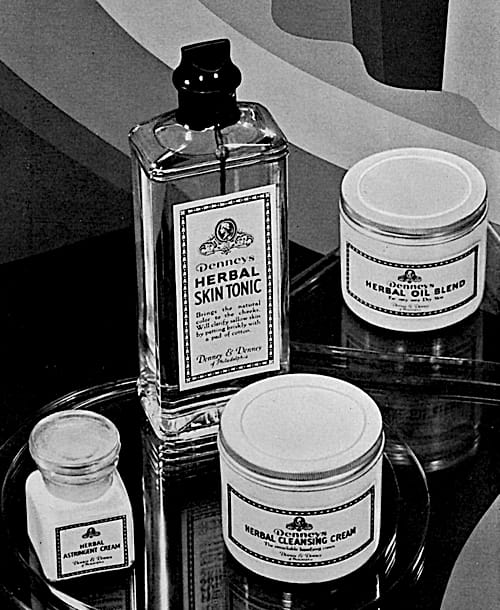
Above: 1930 Denneys Herbal Preparations.
Other American companies claimed to use herbs in some of their preparations but Denney & Denney is the first American cosmetic company, that I know of, to create a range like this. Helena Rubinstein did something similar but her version came out later.
See also: Helena Rubinstein (1930-1945)
The initial Herbal Preparations range consisted of Frances Denney Herbal Cleansing Cream, Herbal Skin Tonic, Herbal Oil Blend, Herbal Texture Lotion, Herbal Circulation Mixture, Herbal Throat and Neck Blend, Herbal Astringent Cream, and Herbal Cleansing Meal. Herbal Cream Masque, a frothy, strawberry-coloured cream, was added in 1932. Herbal Skin Tonic was available in 1929 so it is possible that the company was planning the range before the 1929 stock market crash.
Herbal Cleansing Cream: “Irrepressibly soft and doubly penetrating. Melts quickly with the warmth od the skin, penetrates pores and gently removes all powder, dust, rouge and impurities. It is so mild that it can be used on the most sensitive skin—and is easily removed with cleansing tissues.”
Herbal Cleansing Meal: “[I]t will remove dead cells no longer necessary to the skin and clear the way for the pores to function properly.”
Herbal Skin Tonic: “A delightful preparation needed by almost every skin. It freshens and invigorates the skin by awakening sluggish cells and by stimulating active circulation through the facial network.”
Herbal Oil Blend: “One of the most nourishing preparations ever created for the sin and underlying tissues. It is marvellous for filling out hollows and restoring youthful contour to the face. Very dry and sensitive skins respond gratefully to its soothing unguents. It is especially effectual for the face that is aging.”
Herbal Astringent Cream: “A soft, fluffy cream with astringent qualities. A thin oil on the skin protects against sun and wind and is a splendid base for powder.”
Herbal Texture Lotion: “A deep pore liquid cleanser—wonderful for that quick freshening-up in the morning and during the day. It will be used by the ultra-fastidious woman to remove the last vestiges of cleansing cream from the skin, and to impart a luxurious feeling of cleanliness.”
Herbal Circulation Mixture: “It is marvellously effective in brightening dull, sallow skin by developing vital circulation through the skin tissues.”
Herbal Throat and Neck Blend: “It tightens drooping muscles and irons out lines and wrinkles. It also has nourishing properties.”
Herbal Cream Masque: “To relieve that tired, worn look—and to give renewed vitality, colour and clearness to the skin.”
See also: Frances Denney Herbal Preparations (1930)
Treatments
These herbal preparation were combined with others in a range of treatment regimes which largely followed a cleansing, stimulating and nourishing routine. For example, the Circulation Treatment for Normal skin types began by cleansing the skin with Herbal Cleansing Cream then stimulating it with Herbal Skin Tonic before finishing with nourishing Tissue Cream.
CLEANSING: At night before retiring, cleanse the face thoroughly with Herbal Cleansing Cream. You will find that this smooth, efficient Preparation melts with the warmth of the skin and penetrates the pores and removes all the little dust particles and impurities easily and quickly. Make a pad of cotton that has been moistened with Skin Tonic or cold water and then squeezed out. Dip the pad in Herbal Cleansing Cream. With this pad “wash” the face and neck just as you would use a wash cloth. Remove every trace of cream with Frances Denney Cleansing Tissues, which are imported from Japan.
STIMULATING: When the pores are freed from all impurities so that the skin can breathe freely, moisten a new pad of cotton with Herbal Skin Tonic and pat the face briskly. You will feel within a moment the healthy freshness and stimulation as circulation increases and fresh blood moves through the facial network. This should be continued for several minutes.
NOURISHING: Now, when the skin is vitally alive and every nerve tingles, is the time to nourish the skin with Tissue Cream, which is absorbed through the pores and builds up the tissues, preserving the contour of youth. Smooth the Cream over the face, neck and throat, following the movements shown on the chart. Allow a thin film of Cream to remain on the skin over night, so that it will be absorbed by the skin. In the morning remove all trace of cream and bathe with Herbal Lotion, patting it into the skin for three or four minutes. A vitally-alive feeling will come to the skin, which is now ready for Protection and make up.(Frances Denney, 1933, pp. 10-11)
For Dry Skin, Frances Denney recommended Cleansing Cream, Mild Skin Tonic, and Herbal Oil Blend. Oily skin types were to use Herbal Lotion, Herbal Cleansing Meal, Mild Astringent, and Pore Refiner.
Specialist treatments included using: Special Astringent to tighten and tone facial muscles; Herbal Throat and Neck Blend to nourish, stimulate and strengthen the skin, muscles, and tissues of the neck; Herbal Cleansing Meal, Mild Astringent, and Pore Refiner to treat blackheads and enlarged pores; and Special Bleach Cream, Skin Bleach and Freckle Lotion, and Circulation Mixture to remove freckles, tan and other skin discolourations.
See also: The Affairs of Beauty (1933)
Frances Denney generally preferred ‘patting’ rather than massage when applying her preparations. Patting was done with a cotton pad saturated with the preparation or with the fingers and, as far as I can tell, the company did not use a patter or a mechanical massaging device.
RELAXED or SAGGING MUSCLES
Relaxed or Sagging Muscles may bring lines and wrinkles, crepey throat and double chin. Age is not always the cause; often illness, malnutrition and improper reduction of weight produce this fault. When the tissues are well nourished and the muscles strengthened and skin tightened and a healthy circulation exists the contour becomes firm and well shaped.
Every trace of Herbal Cleansing Cream must be removed before applying Tissue Cream. … [Pat] the rich cream into the skin and allowing twelve to twenty minutes for this step. Muscle Oil is then spread over the cream. Lift the cheek with one hand and pat with another. At this point make a four-finger pad of cotton and saturate with Special Astringent. Pat this firmly on the muscles on either side of the mouth and on the muscles in front of the ear, allowing to dry. You will feel the tingling, penetrating effect of the Special Astringent. If the effect is too severe for your skin, Velvet Cream will soothe it.(Frances Denney, 1933, p. 8)
However, light stroking massage (effleurage) with the fingertips along muscle lines was used in some cases. Frances Denney referred to this as ‘ironing’
Ironing is a slow pressure exerted much in the nature of that of an iron, with the flay of the fingertips. In carrying out these movements it is very important that the natural lines of the muscles of the face be followed, and always in an upward and outward direction. It is natural that a muscle will be strengthened when treated along the line of its normal course, whereas it may be further weakened and sag if pressure or pull is exerted on it crosswise or downwards.
(Frances Denney, 1933, p. 9)
This has some similarity with the heated facial irons used in a few salons at this time. Like them, it was supposed to help even out wrinkles.
See also: Facial Irons
Sun-care
In 1934, Frances Denney added two sun preparations, Herbal Sun Oil and Anti-Sun Cream, the latter occasionally referred to as Herbal Sun Cream.
Herbal Sun Oil: “Helps you achieve a smooth tan without the pain of burning.”
Anti-Sun Cream/Herbal Sun Cream: “Prevents reddening, blistering of the skin . . excellent foundation for make-up.”
Frances Denney added Tan and Protect in 1939. It was sprayed on the skin using an atomiser just like a perfume. I’m not sure how well this would have worked under actual beach conditions with sand potentially gumming up the works.
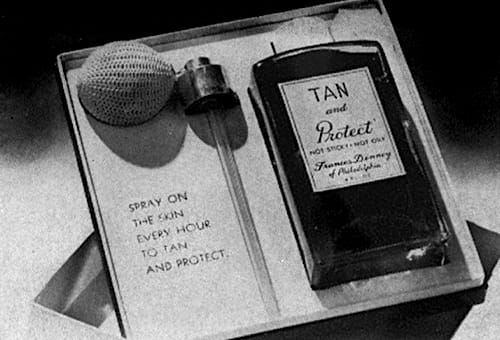
Above: 1940 Frances Denney Tan and Protect.
Tan and Protect: “[A] non-sticky, non-oily lotion to be sprayed on the exposed skin every hour.”
Other warm weather products included Creme Parfait (1934), Summer Cleansing Mixture (1937), and Hot Weather Mask (1940). Creme Parfait was a foundation that could be also be used as a sun protectant. Summer Cleansing Mixture was applied with a pad of cotton saturated with Skin Tonic which left the skin feeling cleansed and refreshed with no trace of stickiness after it was removed with tissues. Hot Weather Mask seems to have been mainly recommended as a refreshing summer treatment to be used before applying evening make-up.
Summer Cleansing Mixture: “[T]he first mixture to be especially created for summer! A light cream, cooling, cleansing.”
Hot Weather Mask: “One quick application whisks all trace of hot weather havoc. Your skin feels—and looks—soft and smooth and cool!”
Youth market
In 1940, Frances Denney introduced a set of skin-care products specifically for younger and/or more sensitive skins – Mild Cleansing Cream, Mild Skin Cream, and Mild Skin Lotion. Packaged together in a Mild Treatment Box none of the products seems to have contained any anti-bacterial ingredients to help clear skin blemishes like those found in Rose Laird’s Young Skin range (1938). However Frances Denney did sell Cleansing Meal, and Porette Cream for clearing the skin of pimples and combatting enlarged pores.

Above: 1940 Frances Denney Mild Treatment Box.
See also: Rose Laird
Other skin-care
The next significant skin-care line released by Frances Denney after the introduction of the Herbal Preparations range was Oils of the Wilderness. Introduced in 1933, it retailed at the astonishing price of US$25.00 per jar, although a US$5.00 trial size was also available. After cleansing the skin, it was left on the face and neck for 12 to 30 minutes during which it was said to ‘penetrate the underlying tissues stimulating cell activity and tightening muscles giving the skin new vitality and improved texture’.
Oils of the Wilderness: “[M]ade of rare essential oils from the wilderness of a far country, blended into a cream that does rejuvenate!”
By 1941, Oils of the Wilderness – then claimed to be the most expensive cream in the world – was being marketed as a Lipoid Cream. According to Frances Denney lipoids were “certain secretions of the glands of the body used by cells in their process of living but which diminish as the years pass”. Although we can probably substitute oils for lipoids, the description used by Frances Denney has some similarity with claims made for the new hormone and glandular creams that were rapidly becoming the new vogue in skin-care in the 1930s.
Also see: Hormone Creams, Oils and Serums
In addition to competing with hormone creams, the marketing change for Oils of the Wilderness may have been influenced by the passing of the Wheeler-Lea, and Food, Drug, and Cosmetic acts in 1938. This legislation clamped down on exaggerated product claims including those that made ‘drug-like’ assertions such as ‘stimulating cell activity’. Other Frances Denney products were also affected by the 1938 legislation. For example, the company was forced to rename its Tissue Cream as Skin Cream.
See also: The FDA, FTC and Cosmetics
In 1940, Frances Denney added Night-Tone, a night cream packaged in a bottle similar to the one used for Under-Tone, a new foundation the company introduced in 1939.
Night-Tone: “[I]t disappears almost completely during application . . . no ugly, oily film . . . no grease stains on pillow case.”
Other new lines included Magic Stick Deodorant, a stick version of Magic Cream Deodorant, and Wax Depilatory, an addition to the company’s previous product, Depilatory Powder.
Magic Stick Deodorant: “Safe and sanitary . . generous size . . stops excessive perspiration . . does not irritate skin or injure clothing. Use it under the arms . . or anywhere on the body. You can carry it in your purse.”
Wax Depilatory: “[F]or removing hair from the face, arms, legs, back of neck and underarms, Used regularly, it discourages the growth of hair by gradually weakening the roots.”
Eye Kit
In 1935, Frances Denney introduced Eye Kit, a collection of beauty products specifically for the eyes. The kit contained Special Eye Lotion, Eye Drops, Eye Cream, and Eyelash Grower. Claims for a number of these preparations contravened the Wheeler-Lea, and Food, Drug, and Cosmetic Acts and were also forced to undergo changes in the names and/or the way they were promoted.
Special Eye Lotion: “A cooling and refreshing lotion that brings quick relief to eyes that are tired and aching. Gentle and soothing in its action . . . it can be used as often as necessary. Use it with an eye-cup night and morning.”
Eye Drops: “Wonderfully helpful in relieving inflammation of the eyes or eyelids caused by strain. Use three to five drops in each eye.”
Eye Cream: “A soothing and nourishing preparation which is remarkably effective in removing lines, wrinkles and crow’s feet.”
Eyelash Grower: “Promotes growth of the lashes, making them long, lustrous and silky, and deepens their color. Smooth a tiny bit along the edge of the lids during the day for that well-groomed appearance.”
Make-up
Changes to the Frances Denney make-up range during the 1930s included extending shade ranges and improved colour-coordination between various make-up products with the company producing a number of coordinated make-up kits from 1935 onwards.
Face Powder
Frances Denney face powders available during the 1930s included La Belle Myana Powder, Moist-Proof Powder, Jasmin Flowers Powder, Ultra-Modern Poudre, Poudre de Satin, Poudre No. 42, Gala Face Powder, and Frances Denney Face Powder. Some of these, such as Ultra-Modern Poudre appear to have been named after their containers while others like Jasmin Flowers Powder and Gala Face Powder were expressions of the fragrances used to scent them.
Most of these powders appear to have disappeared by 1940 leaving the more expensive Poudre de Satin, renamed Satiny Poudre, with its high levels of talc, and the cheaper Frances Denney Face Powder as the two most important face powder lines.
Poudre de Satin: “Fine texture, light weight, goes on smoothly with satiny finish that flatters.”
Frances Denney Face Powder: “A softly clinging powder for fastidious women, Sating textured, deliciously perfumed, a requisite for refinement. In new sift proof box.”
As far as I can tell, all Frances Denney face powders came in the same shades. In 1933, this included Blanche, Naturelle, Paris Blend, Cream, Rachel, Castilian, and Ochre tones with shades like Russet, and Champagne (1935); Derby (1938); Red Camelia, Bois de Rose, and Purple Iris (1939); Watermelon, and Knockout (1940); and Argentine (1941) added through to America’s entry into the Second World War.
Foundation
Prior to 1930, Frances Denney Foundation Cream was the company’s main powder base. This appears to have been a colourless vanishing cream but all the other Frances Denney foundations that I know about that were added during the 1930s were coloured. These began with Foundation Lotion (1932), which was followed by the previously mentioned Creme Parfait (1934), then Make-up Film (1937), and Under-Tone (1939). Unlike the Frances Denney face powders, the shade ranges for these preparations differed.
Foundation Lotion: “[I]mparts velvety softness to your skin . . safeguards it from sun or wind-burn . . and comes in shades to match your complexion and tone your skin for the right make-up.” Shades: White, Rachel, Ochre, and Castilian, along with two evening shades and Chartreuse, and Orchid.
Creme Parfait: “[A]dapts itself handily to either dry skin or an oily one. Spread it on smoothly, without hurrying, and your make-up will remain intact from dawn to dusk—or dark till dawn.” Shades: Bronze, Paris Blend, Blanche, Rachel, and Russet, with Castilian, and Champagne added in 1935.
Make-up Film: “Your skin must be prepared to ‘receive’ make-up. … Make-Up Film helps you acquire a smooth, glowing, youthful – looking skin.” Shades: Light, Medium, and Dark.
Under-Tone: “[P]owder base, especially efficient for dry skin. It’s thin and non-flaky, highlights the texture of your skin without changing the natural appearance. Shades: Soft, Deep, and Brilliant, with Argentine added in 1941.
Under-Tone deserves special mention as it was the first Frances Denney cosmetic to use the ‘Tone’ label. Others included the previously mentioned Night-Tone, as well as Body-Tone, Over-Tone, Neck-Tone, and Hand-Tone.
Lipstick
Frances Denney lipsticks came in a very limited range of shades in 1933 – Light, Medium, Dark, and Paris Blend – but a number of new colours were added through to 1941. New shades that I know of were: Russet (1934); Castilian, and Champagne (1935); True Red (1936); Derby Red (1938); Cinnamon Stick, Dramatic Red, Night Club, Knockout Red, Watermelon, Red Camellia, Bois de Rose, and Purple Iris (1939); Independence Red, Wild Rose, Cinnamon, and Dark Wine (1940); and Argentine, and Indispensable (1941).
There very is little information on Frances Denney lipsticks cases from the 1930s. Those that I have evidence for are: the Formal Lipstick (1934), an automatic case design that matched the Formal Compact; Jewelled Lipstick (1935), a twist up which came in black cases with white imitation diamonds or white cases set with imitation ruby, emerald, diamond or sapphire stones; and the Starglow lipstick cases (1936). The Starglow case outlasted the others which were discontinued in 1938 and 1939 respectively.
In 1940, Frances Denney introduced Three-on-a-Match, a lipstick wardrobe made up of three white, enamel-encased lipsticks – Watermelon, Knockout Red, and Night Club – suitable for morning, afternoon, and evening respectively, along with a mirror.
A second lipstick wardrobe called Do-Re-Mi, that substituted Derby Red for Knockout Red, was added in 1942. Another Three-on-a-Match set introduced after the war included Raspberry Red rather than Knockout Red or Derby Red.
Rouge
Frances Denney rouge shades from the early 1930s were not matched by name with Frances Denney lipsticks. For example, in 1933 Frances Denney lipsticks came in Light, Medium, Dark and Paris Blend,but Cream Rouge shades were Light Brigade, Red Rose, Paris Blend, Red Top, and Dark Brigade, and Compact Rouge shades were Rozell, Geranium, Medium, and Raspberry. This changed after 1935 with rouge shades generally added concurrently with new shades of lipstick. When Satin Rouge Compacts were discontinued in 1939 their shade range included Raspberry, Carmine, Medium, Geranium, Paris Blend, Castilian, Champagne, Russet, True Red, Light Brigade, and Dark Brigade.
Eye make-up
Frances Denney made all the main types of eye make-up including eyeshadows, eyebrow pencils and cosmetique, the later being a block or cake mascara. Unfortunately I only have shade ranges for the early 1930s which are as follows:
Eye Shadow: Sky Blue, Dark Blue, Light Brown, Dark Brown, Black, Bronze, Green, and Lavender.
Cosmetique: Light Brown, Dark Brown, Sky Blue, Dark Blue, Green, and Black.
Eyebrow Pencil: Black, Blonde Brown, and Titian Brown.
Colour Coordination
Frances Denney provided clients with information on how to colour coordinate shades of make-up using hair colour as the basis for her colour classification.
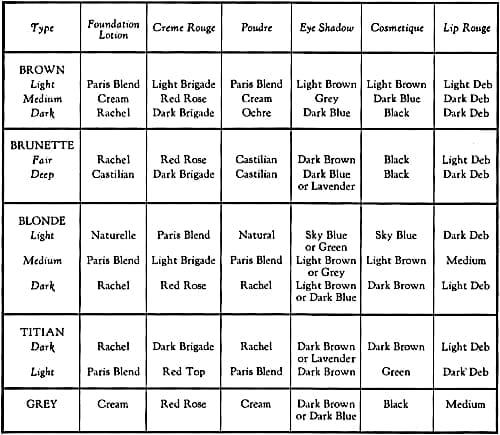
Above: 1933 Frances Denney Colour Chart.
In 1935, Frances Denney took this one step further, releasing four sets of Matched Make-up each based on one of her more popular shades of make-up – Russet, Paris Blend, Castilian, and Champagne. Each set came with an appropriately colour-coordinated Lipstick, Cream Rouge, Face Powder, Foundation Lotion, and Creme Parfait.
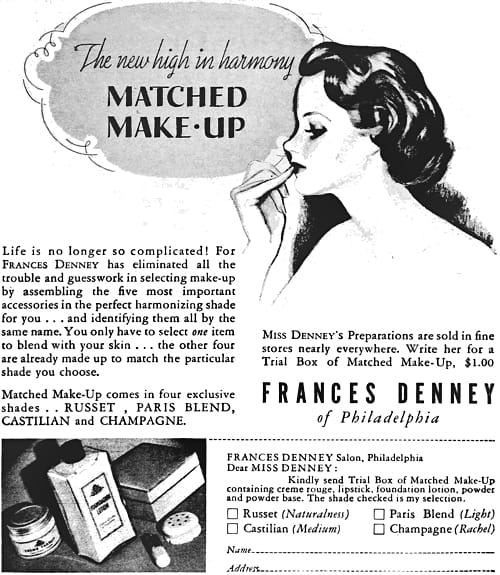
Above: 1935 Frances Denney Matched Make-up.
The arrival of Under-Tone in 1939 also saw the development of some novel Matched Make-up Kits combining Under-Tone with more recent lipstick shades.
In 1941, Frances Denney then combined the Match Make-up and Three-on-a-Match ideas to create a series of matched make-up kits each containing a harmonising lipstick, face powder, and nail lacquer along with an actual box of matches. This is the only record I have for a Frances Denney nail polish. There were four versions of this kit – Derby Red, Independence Red, Knockout Red, and Watermelon, with Argentine, and Indispensable versions added later in the year. The lipsticks were enclosed in Starglow cases, the harmonising Frances Denney Face Powders in the pink boxes introduced in 1940.
In 1943, Frances Denney ‘borrowed’ an idea from Elizabeth Arden and also began advertising that women could wear any colour if she used an appropriate shade of face powder.
Miss Denney’s exquisite Face Powders are blended, with scientific accuracy, to prevent ‘color discord’ between your skin tones and any Costume color.
If certain colours have made your skin seem drab or even sallow . . . if other colours your skin too bright . . . you can prevent these ‘color discords’ by selecting the right shade of Frances Denney Face Powder.(Frances Denney advertisement, 1943)
Frances Denney combined this with another Elizabeth Arden development – double powder boxes.
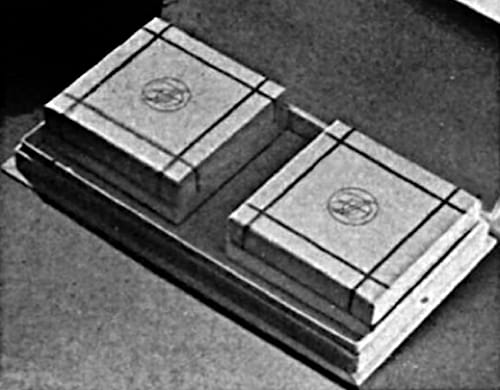
Above: 1943 Frances Denney Double Powder. In six different skin tones. “One, neutral as beige, to combat the purple patches some colors give you. The other, sparkling with pink, to put back the roses some colors take from your cheeks.”
See also: Elizabeth Arden (1930-1945)
War
Frances Denney managed to introduce a number of new products during the Second World War, although most arrived in 1942 which was shortly after America joined the hostilities. Some steps were taken to move to wartime packaging but most products remained dressed in the packaging redesign done by Raymond Loewry in 1940.
Skin-care
New skin-care products introduced during the war included Frances Denney Foot Lotion, Foot Balm, and Neck-Tone (1942), and Hand-Tone (1943).

Above: 1942 Frances Denney Neck-Tone, a masque-like astringent that came with its own brush to be applied at night or just before make-up. After cleansing the neck and then removing any trace of oiliness with Skin Freshener, Neck-Tone was left on for 20 to 30 minutes until it was dry after which it was removed with water.
Neck-Tone: “An efficient stringent type preparation. Gives an immediate tightening effect to outer skin texture.”
Hand-Tone: “Everybody loves smooth, soft hands . . . and everywoman wants them. You can have beautiful hands very easily . . . smooth on a little Frances Denney Hand-Tone. No trouble . . . no stain on linen . . . and wonderfully effective.”
In 1944, Frances Denney ran a nationwide advertising campaign suggesting using Hand-Tone as a protective skin coating for the use of gardeners before they start digging using the slogan ‘Victory Hands for Victory Gardeners’.
Make-up
Frances Denney also added new shades of make-up to its range during the war. New face powder shades included: Allegiance (1942); American Blend, and Whirlwind (1943); Pink Lilac (1944); and Romance (1945). The new lipsticks shades that I know of were: Allegiance Red (1942); American Blend, and Whirlwind (1943); Red lilac (1944); and Romance Red (1945). The company also switched to plastic Bifex lipstick cases in 1943 due to the metal shortage.
In 1942, Frances Denney debuted Over-Tone, a copy of Max Factor’s highly successful Pan-Cake make-up (1938). Like Pan-Cake, Over-Tone was applied with a damp pad then blended with the fingertips.
Over-Tone: “This cake make-up works for that wonderful ‘look-alive’ look. … Just smooth it on with a damp pad, then blend it with your fingertips. Your skin will keep a healthy, natural glow through hours of rush-rush.” Shades: Soft, Brilliant, Deep, and Argentine, with American Blend, and Whirlwind added in 1943.
Also see: Pan-Cake Make-up
Over-Tone could be used as a stocking substitute but Frances Denney also developed Leg Make-up Film in 1942, a liquid cosmetic stocking that only came in one shade. Like other products of this type, that came into vogue when silk and nylon stockings disappeared from the shelves during the war, the first formulation was less than unsatisfactory and the company introduced an improved form the following year.
Leg Make-Up: “Film in an exquisite golden tan shade. It goes on smoothly and easily, dries quickly . . . gives your legs the same sleek beauty that sheer stockings do.”
Also see: Cosmetic Stockings
Corrective Beauty
In 1943, with many women busy with the war effort, Frances Denney began to describe many preparations as corrective, suggesting that they were essential but also pointing out that they required little time or effort to use.
You can take only a little time out of your busy life for beauty–so make every minute count! Frances Denney Corrective Beauty Preparations are easy to use . . . so effective they make proper beauty care something you need never neglect.
Frances Denney advertisment, 1943)
By the following year, Frances Denney was grouping a number of corrective preparations into treatments which included regimes for different skin types:
Dry Skin – Cleansing Cream, Mild Skin Lotion, Herbal Oil Blend, and Throat and Neck Blend.
Oily Skin – Special Cleansing Cream, Mild Skin Cream, Cleansing Meal, Special Skin Lotion, and Porette Cream.
Normal Skin – Mild Cleansing Cream, Mild Skin Lotion, and Mild Skin Cream.
The company would continued this corrective preparations theme after the war.
Timeline
| 1904 | Victoria Toilet Company founded at 1008 Walnut Street, Philadelphia. |
| 1910 | Denney & Denney, incorporates. |
| 1918 | New Products: Myana range. |
| 1922 | New Products: White Mud Pack. |
| 1927 | New York office opened at 11 West 42nd Street. New Products: Milk-O-Bath; and Crême Mercedes. |
| 1930 | New Products: Herbal Preparations range. |
| 1931 | New Products: Herbal Cream Masque. |
| 1932 | New Products: Foundation Lotion. |
| 1933 | New Products: Oils of the Wilderness. |
| 1934 | New Products: Herbal Sun Oil; Anti-Sun Cream; Magic Stick; and Creme Parfait. |
| 1936 | New Products: Starglow lipstick and rouge cases. |
| 1937 | New Products: Summer Cleansing Mixture. |
| 1938 | New Products: Make-up Film; and Make-up Mask. |
| 1939 | New York office moved to 610 Fifth Avenue. New Products: Under-Tone. |
| 1940 | New packaging designed by Raymond Loewy. New Products: Mild Cleansing Cream; Mild Skin Cream; Mild Skin Lotion; Tan and Protect; and Night-Tone. |
| 1941 | New Products: Eau de Cologne Deodorant; and Over-Tone. |
| 1942 | New Products: Foot Lotion; Foot Balm; Neck-Tone, and Leg Make-up Film. |
| 1943 | New Products: Hand-Tone. |
Continued onto: Frances Denney (post 1945)
First Posted: 23rd March 2023
Last Update: 18th April 2023
Sources
The American perfumer & essential oil review. (1906-1955). New York: Robbins Perfumer Co. [etc.].
Denney & Denney. (1930). Frances Denney presents her herbal preparations. A new concept in the science of skin treatment [Booklet]. Philadelphia: Author.
Frances Denney. (1933). The affairs of beauty. A brief presentation of some of the treatments and preparations of Frances Denney from the salon in Philadelphia [Booklet]. Philadelphia: Author.
The drug and cosmetic industry. (1932-1997). New York: Harcourt Brace Jovanovich [etc.].

Anna V. Denney [1869-1939].
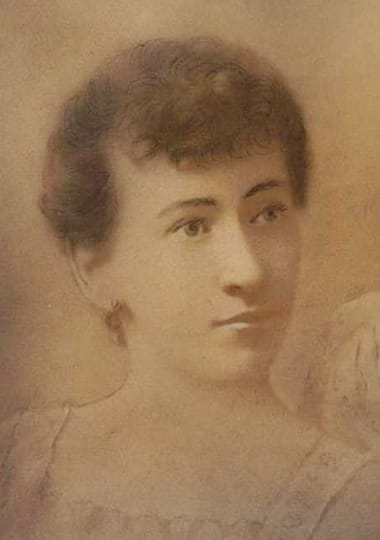
Helen M. Denney [1871-1941].
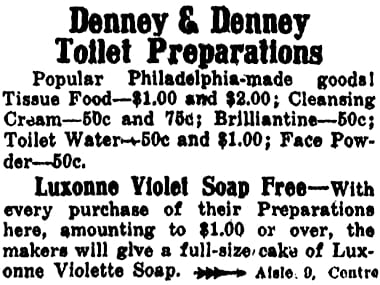
1909 Denney & Denney. Part of an advertisement for Strawbridge & Clothier, a department store on Market Street, Philadephia.
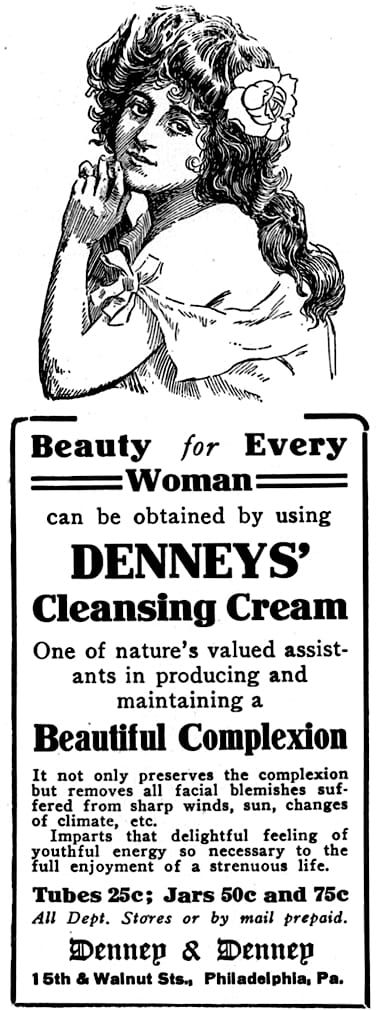
1910 Denneys Cleansing Cream.

1913 Denneys Complexion Powder.

1914 Denney & Denney Hairdressing and Manicuring.
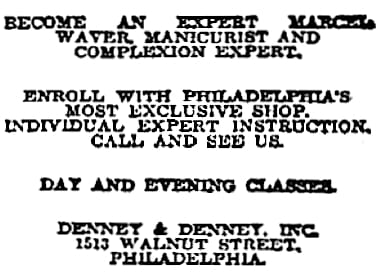
1920 Denney & Denney training school.
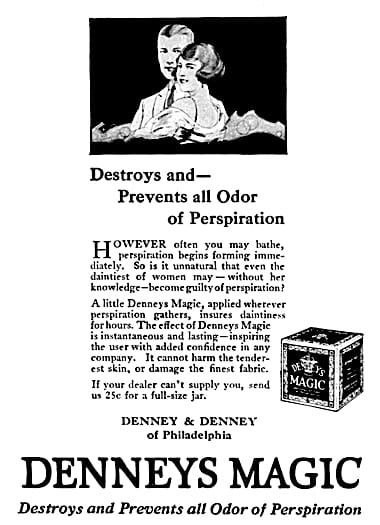
1920 Denneys Magic.
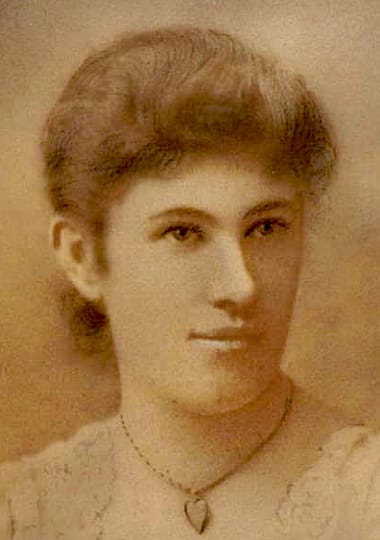
Elizabeth Frances Denney [1865-1953].
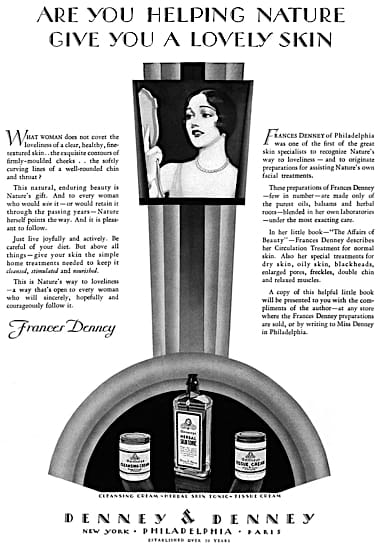
1928 Frances Denney.
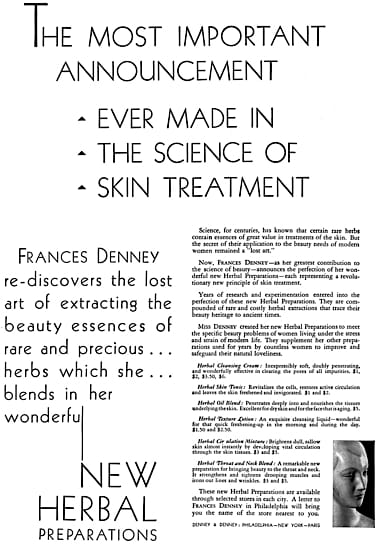
1930 Frances Denney Herbal Preparations.
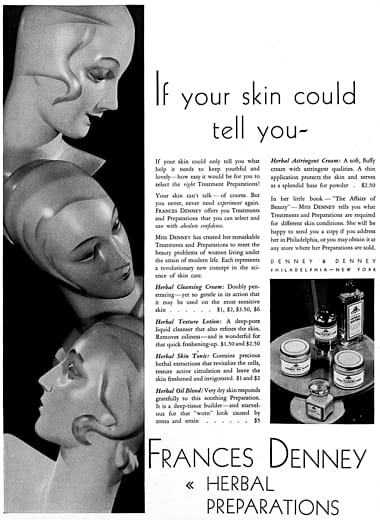
1931 Frances Denney Herbal Preparations.
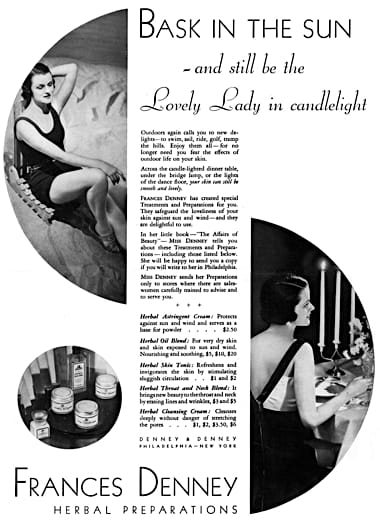
1932 Frances Denney.
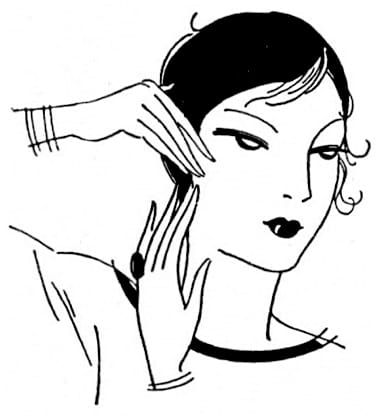
1933 Frances Denney. Patting with a pad of cotton or the fingertips should be done ‘briskly enough to cause a slight tingling sensation’.
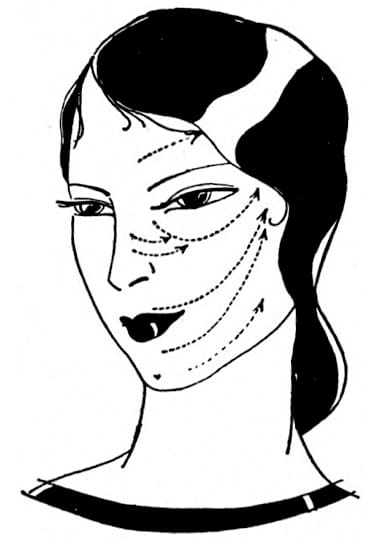
1933 Frances Denney. Ironing the face has a ‘soothing effect and gradual relaxation that evens out wrinkles’.
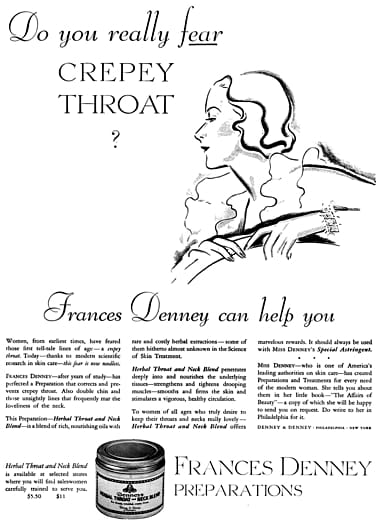
1933 Frances Denney Herbal Throat and Neck Cream.

1934 Frances Denney Formal Compact and Lipstick. The Formal Lipstick came in Light, Medium, Vivid, and Russet shades.
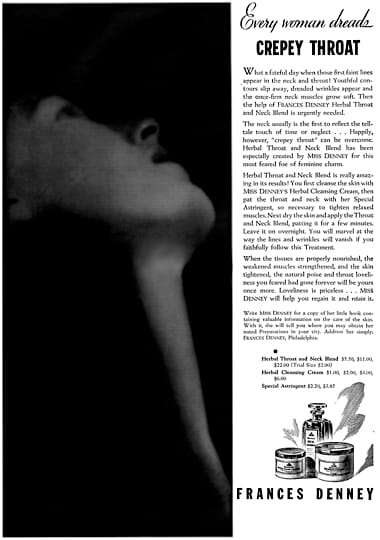
1934 Frances Denney crepey throat treatment.
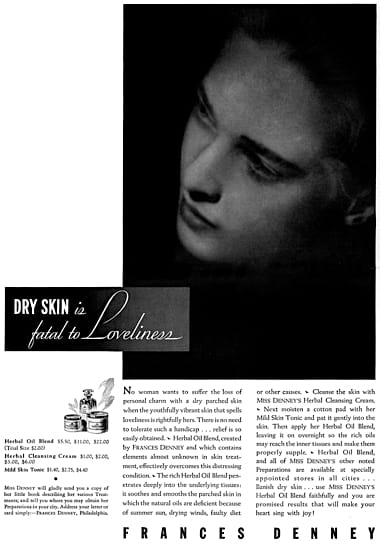
1934 Frances Denney dry skin treatment.
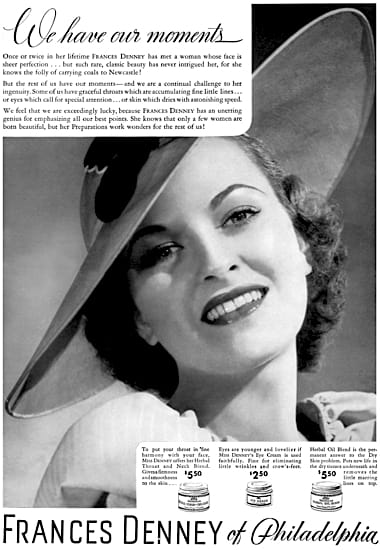
1936 Frances Denney.
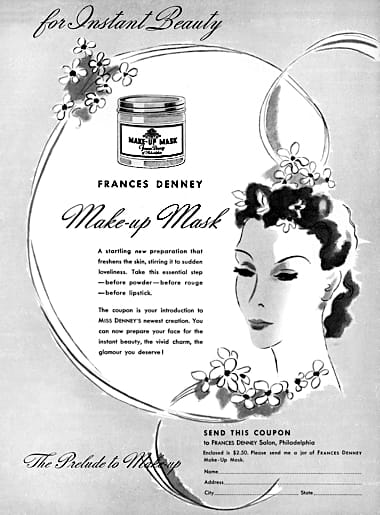
1938 Frances Denney Make-up Mask.
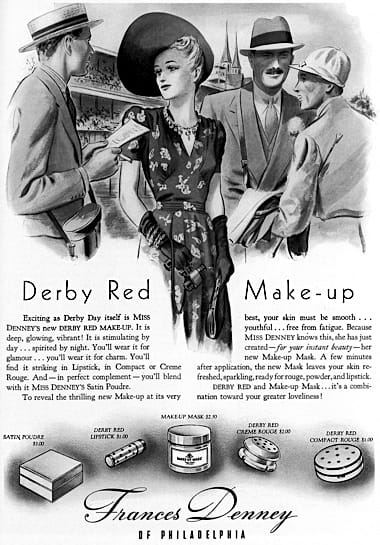
1938 Frances Denney Derby Red with lipstick, rouge, and compact in Starglow cases. The shade was later just referred to as Derby.

1938 Frances Denney.
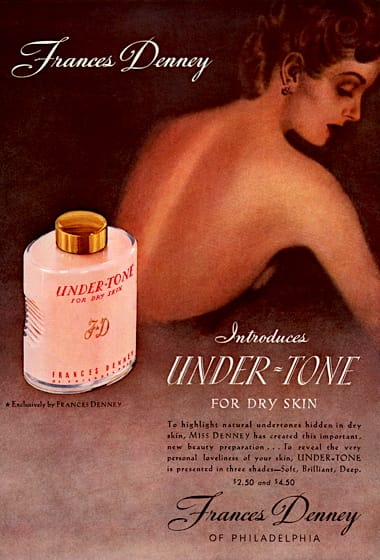
1939 Frances Denney Under-Tone.
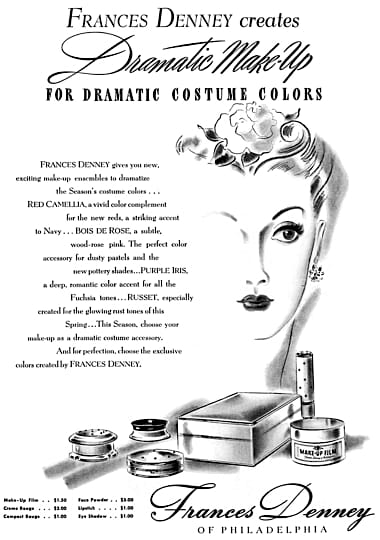
1939 Frances Denney Dramatic Make-up.
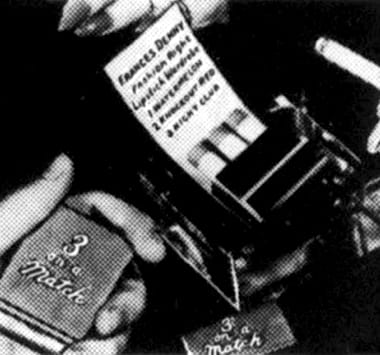
1940 Frances Denney Three-on-a-Match.

1940 Frances Denney Watermelon, and Knockout Red.
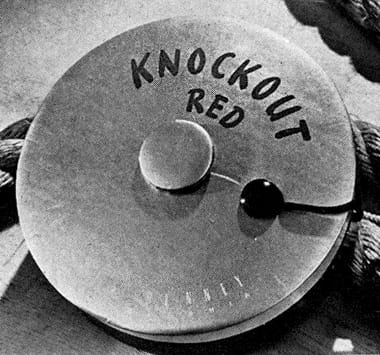
1940 Frances Denney Knockout Red container holding lipstick, rouge, eyeshadow, and Under-Tone.

1941 Frances Denney Oils of the Wilderness.

1941 Frances Denney 3-on-a-Match.

1941 Frances Denney Night-Tone.
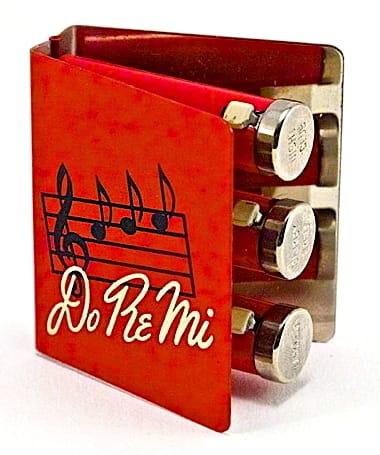
1942 Frances Denney Do-Re-Mi lipstick wardrobe containing Watermelon, Derby Red and Night Club lipsticks.
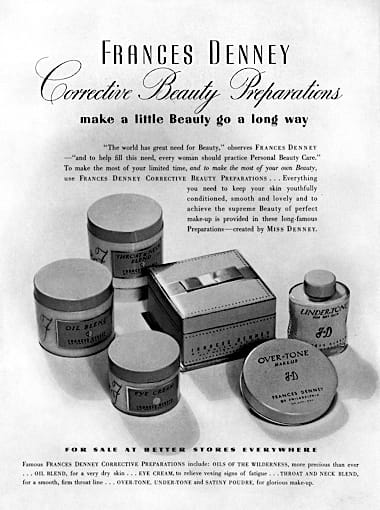
1942 Frances Denney Corrective Beauty Preparations in packaging designed by Raymond Loewry in 1940.
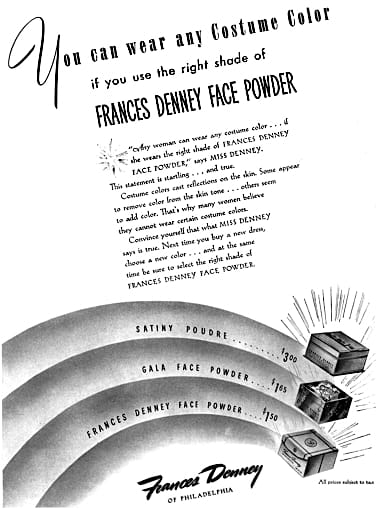
1943 Frances Denney Face Powder, Gala Face Powder, and Satiny Poudre.
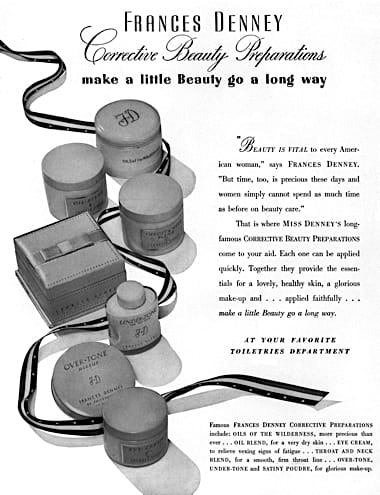
1943 Frances Denney Corrective Preparations.
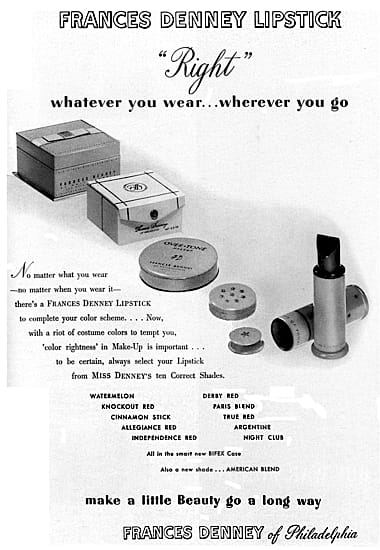
1943 Frances Denney Lipsticks.

1943 Frances Denney Face Powder and Satiny Poudre.
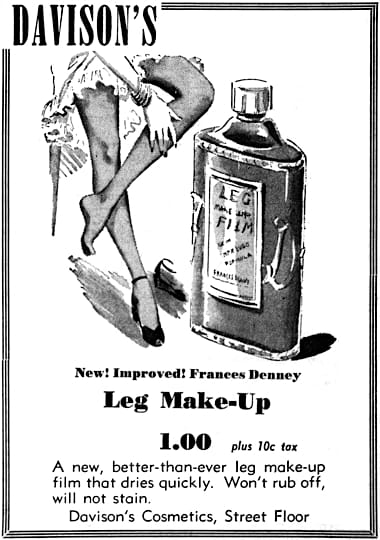
1943 Frances Denney Leg Film.
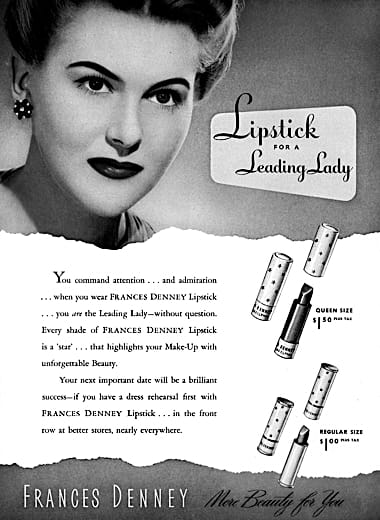
1944 Frances Denney Queen and Regular Starglow Lipsticks.
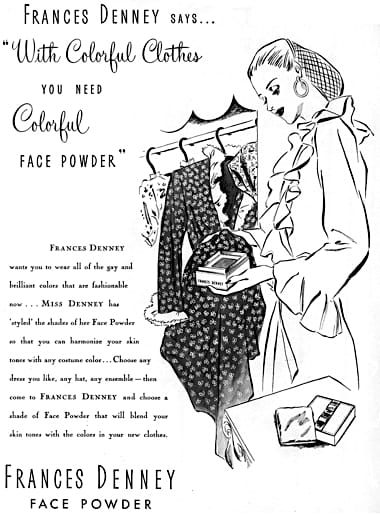
1944 Frances Denney Face Powder.
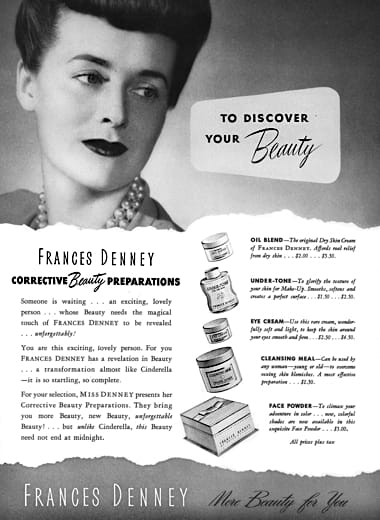
1944 Frances Denney Corrective Preparations.
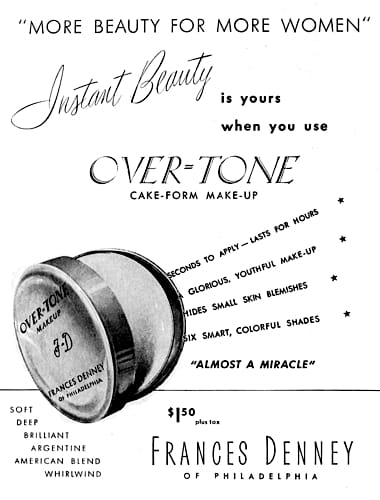
1944 Frances Denney Over-Tone.

1945 Frances Denney Oils of the Wilderness.
